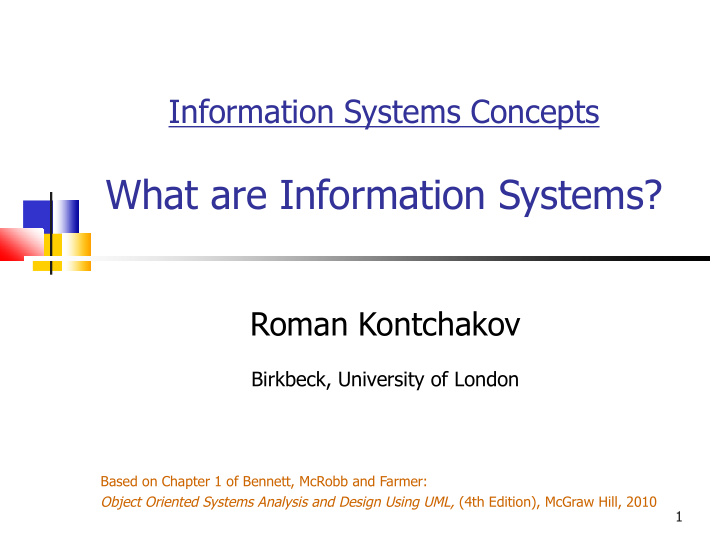



Information Systems Concepts What are Information Systems? Roman Kontchakov Birkbeck, University of London Based on Chapter 1 of Bennett, McRobb and Farmer: Object Oriented Systems Analysis and Design Using UML, (4th Edition), McGraw Hill, 2010 1
Outline n Information and Information Systems n Section 1.5 (pp. 33 – 38) 2
IS – Types n Operational Systems automate the routine, day-to- day record-keeping tasks n Management Support Systems help managers to decide or to communicate n Office Systems automate or assist in the work of office workers, e.g. clerks, secretaries, typists and receptionists. n Real-Time Control Systems typically operate physical equipment, often in safety-critical settings such as ……. 3
IS for three levels of management Level of Focus of Typical IS Typical IT Pivotal management decision applications solutions concept making Operational day-to-day staff payroll, invoicing, database, activities and Data operative purchasing, application production support management accounting generator Tactical policies in support budget analysis, data warehouse, of short-term goals Information line salary forecasting, analytical and resource management inventory scheduling, processing, allocation customer service spreadsheets Strategic strategies in market and sales data mining, support of analysis, product Knowledge executive/ knowledge organizational long- planning, performance senior management term objectives evaluation management --- Maciaszek, L.A.: Requirements Analysis and System Design , (3 rd ed). Addison Wesley, 2007 4
Data, Information and Knowledge n Data = raw facts representing values, quantities, concepts and events pertaining to business activities n e.g., telephone numbers n Information = data that have been processed or summarized to produce value-added facts, revealing features and trends n e.g., telephone numbers grouped by their areas, industries n Knowledge = understanding of information, obtained by experience or study, and resulting in the ability to do things effectively and efficiently. tacit (in a person’s mind) or documented (in some form) n n e.g., how the telephone numbers can be used in telemarketing to entice people to buy products --- Maciaszek, L.A.: Requirements Analysis and System Design , (3 rd ed). Addison Wesley, 2007 5
IS: operational systems n OnLine Transaction Processing (OLTP) systems n Transaction – a logical unit of work that accomplishes a particular business task and guarantees the integrity of the database after the task completes n Database technology n persistent storage n concurrency control n integrity constraints n security --- Maciaszek, L.A.: Requirements Analysis and System Design , (3 rd ed). Addison Wesley, 2007 6
IS: tactical management systems n OnLine Analytical Processing (OLAP) systems n Analysis of pre-existing historical data to facilitate decision making n Data warehouse technology n summarizing (aggregation) n packaging (into graphs, charts, spreadsheets, animations, ...) n partitioning (reducing amount of data) n Data marts subset of data relevant to a particular dept/function n Data webhouses --- Maciaszek, L.A.: Requirements Analysis and System Design , (3 rd ed). Addison Wesley, 2007 7
IS: strategic management systems n Knowledge Processing Systems n “know-how” – intellectual capital accumulated through experience n Knowledge Management – to help organizations discover, organize, distribute and apply the knowledge encoded in information systems n Data mining n association (patters of one event leading to another) n classification (facts that fall into predefined categories) n clustering (categories discovered by an algorithm) n AI techniques à predictive rather than retrospective models --- Maciaszek, L.A.: Requirements Analysis and System Design , (3 rd ed). Addison Wesley, 2007 8
Take Home Messages n Different Types of Information Systems n 3 Management Levels n Data, Information and Knowledge 9
Recommend
More recommend